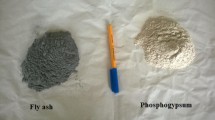Abstract
In the present work, water absorption of lightweight geopolymers produced by fine fly ash, rice husk bark ash and palm oil clinker (POC) aggregates has been modeled based on artificial neural networks. To build the models, training, validating and testing using experimental results from 144 specimens were conducted. The data used in the multilayer feed-forward neural networks models are arranged in a format of six input parameters that cover the quantity of fine POC particles, the quantity of coarse POC particles, the quantity of FA+RHBA mixture, the ratio of alkali activator to ashes mixture, the age of curing and the test trial number. According to these input parameters, in the neural networks models, the water absorption of each specimen was predicted. The best value of R2 was 0.9972 and the minimum value of that was 0.8301. The training, validating and testing results in the neural networks model have shown a strong potential for predicting the water absorption of the geopolymer specimens.


Similar content being viewed by others
Change history
04 July 2020
The Editor-in-Chief has retracted this article [1] because it significantly overlaps with a number of articles including.
References
Wongpa J, Kiattikomol K, Jaturapitakkul C, Chindaprasirt P (2010) Compressive strength, modulus of elasticity, and water permeability of inorganic polymer concrete. Mater Design 31:4748–4754
Lloyd RR, Provis JL, van Deventer JSJ (2009) Microscopy and microanalysis of inorganic polymer cements. 1: remnant fly ash particles. J Mater Sci 44:608–619
Kumar S, Kumar R, Mehrotra SP (2010) Influence of granulated blast furnace slag on the reaction, structure and properties of fly ash based geopolymer. J Mater Sci 45:607–615
Álvarez-Ayuso E, Querol X, Plan F, Alastuey A, Moreno N, Izquierdo M, Font O, Moreno T, Diez S, Vázquez E, Barra M (2008) Environmental, physical and structural characterisation of geopolymer matrixes synthesised from coal (co-)combustion fly ashes. J Hazard Mater 154:175–183
Sata V, Jaturapitakkul C, Kiattikomol K (2007) Influence of pozzolan from various byproduct materials on mechanical properties of high-strength concrete. Constr Build Mater 21(7):1589–1598
Tangchirapat W, Buranasing R, Jaturapitakkul C, Chindaprasirt P (2008) Influence of rice husk—bark ash on mechanical properties of concrete containing high amount of recycled aggregates. Constr Build Mater 22(8):1812–1819
Nazari A, Bagheri A, Riahi S (2011) Properties of geopolymer with seeded fly ash and rice husk bark ash. Mater Sci Eng, A 528:7395–7401
Mohammed BS, Al-Ganad MA, Abdullahi M (2011) Analytical and experimental studies on composite slabs utilising palm oil, clinker concrete. Constr Build Mater 25:3550–3560
Pala M, Ozbay O, Oztas A, Yuce MI (2005) Appraisal of long-term effects of fly ash and silica fume on compressive strength of concrete by neural networks. Constr Build Mater 21(2):384–394
Pak J, Jang J, Bhadeshia HKDH, Karlsson L (2009) Optimization of neural network for Charpy toughness of steel welds. Mater Manuf Process 24:16–21
Cottrell GA, Kemp R, Bhadeshia HKDH, Odette GR, Yamamoto T (2007) Neural network analysis of Charpy transition temperature of irradiated low-activation martensitic steels. J Nucl Mater 367–370:603–609
Nazari A, Riahi S, Bagheri A (2012) Designing water resistant lightweight geopolymers produced from waste materials. Mater Des 35:296–302
Nazari A, Khalaj G (2012) Prediction compressive strength of lightweight geopolymers by ANFIS. Ceram Int 38:4501–4510
Nazari A (2012) Fuzzy logic for prediction water absorption of lightweight geopolymers produced from waste materials. Ceram Int 38:4729–4736
Nazari A (2012) Utilizing ANFIS for prediction water absorption of lightweight geopolymers produced from waste materials. Neural Comput Appl. doi:10.1007/s00521-012-0934-1
Nazari A (2012) Fuzzy logic-based prediction of compressive strength of lightweight geopolymers. Neural Comput Appl. doi:10.1007/s00521-012-1009-z
ASTM C642 (2001) Standard test method for density, absorption, and voids in hardened concrete. ASTM, Philadelphia, PA
Topcu IB, Karakurt C, Sarıdemir M (2008) Predicting the strength development of cements produced with different pozzolans by neural network and fuzzy logic. Mater Des 29:1986–1991
Ince R (2004) Prediction of fracture parameters of concrete by artificial neural networks. Eng Fract Mech 71(15):2143–2159
Sarıdemir M, Topcu IB, Ozcan F, Severcan MH (2009) Prediction of long-term effects of GGBFS on compressive strength of concrete by artificial neural networks and fuzzy logic. Constr Build Mater 23:1279–1286
Liu SW, Huang JH, Sung JC, Lee CC (2002) Detection of cracks using neural networks and computational mechanics. Comput Meth Appl Mech Eng 191(25–26):2831–2845
Gunaydın HM, Dogan SZ (2004) A neural network approach for early cost estimation of structural systems of building. Int J Proj Manage 22(7):595–602
Suratgar AA, Tavakoli MB, Hoseinabadi A (2005) Modified Levenberg–Marquardt method for neural networks training. World Acad Sci Eng Technol 6:46–48
Guzelbey Ibrahim H, Cevik A, ve Erklig A (2006) “Prediction of web crippling strength of cold-formed steel sheetings using neural networks”. J Constr Steel Res 62:962–973
Topcu IB, Sarıdemir M (2008) Prediction of compressive strength of concrete containing fly ash using artificial neural network and fuzzy logic. Comp Mater Sci 41(3):305–311
Author information
Authors and Affiliations
Corresponding author
Additional information
The Editor-in-Chief has retracted this article because it significantly overlaps with a number of articles including those that were under consideration at the same time and previously published articles (see retraction note for details). Additionally, the article shows evidence of peer review manipulation. The author has not responded to any correspondence regarding this retraction.
About this article
Cite this article
Nazari, A. RETRACTED ARTICLE: Prediction water absorption resistance of lightweight geopolymers by artificial neural networks. Neural Comput & Applic 31 (Suppl 2), 759–766 (2019). https://doi.org/10.1007/s00521-012-1136-6
Received:
Accepted:
Published:
Issue Date:
DOI: https://doi.org/10.1007/s00521-012-1136-6




